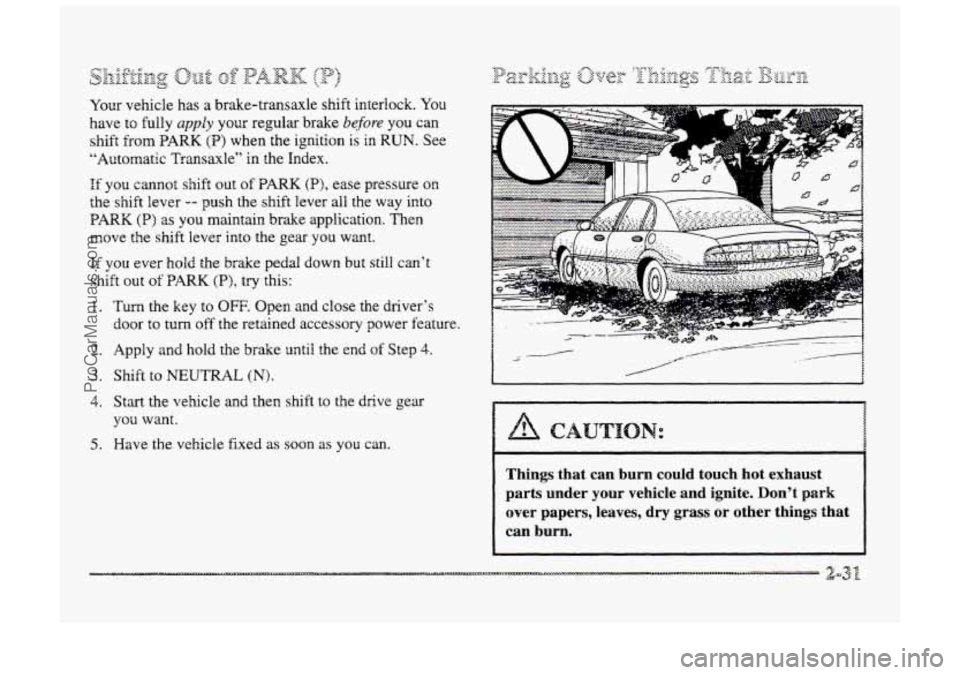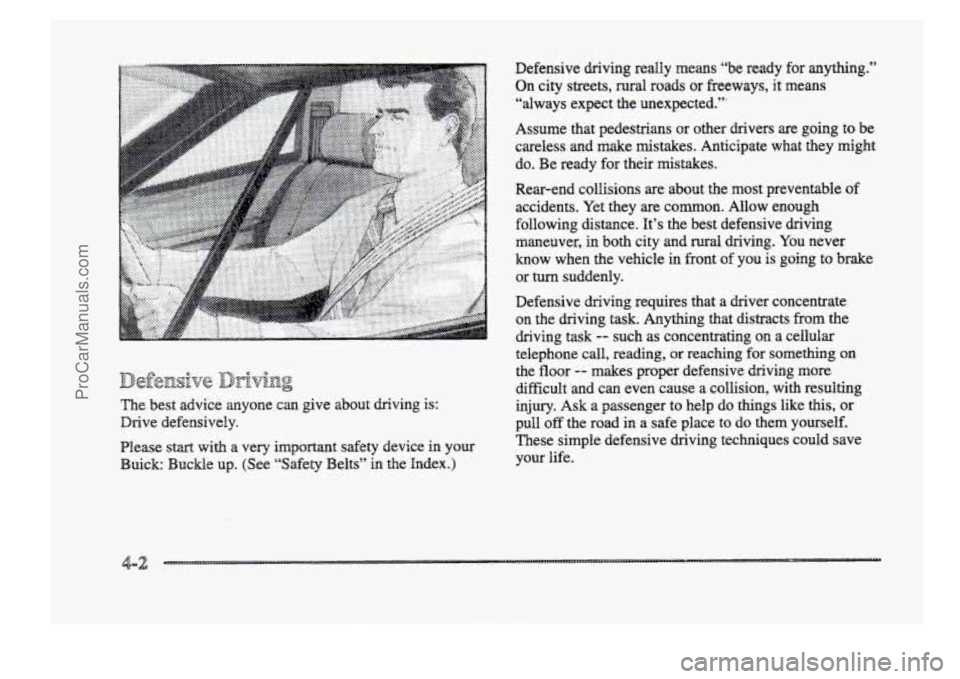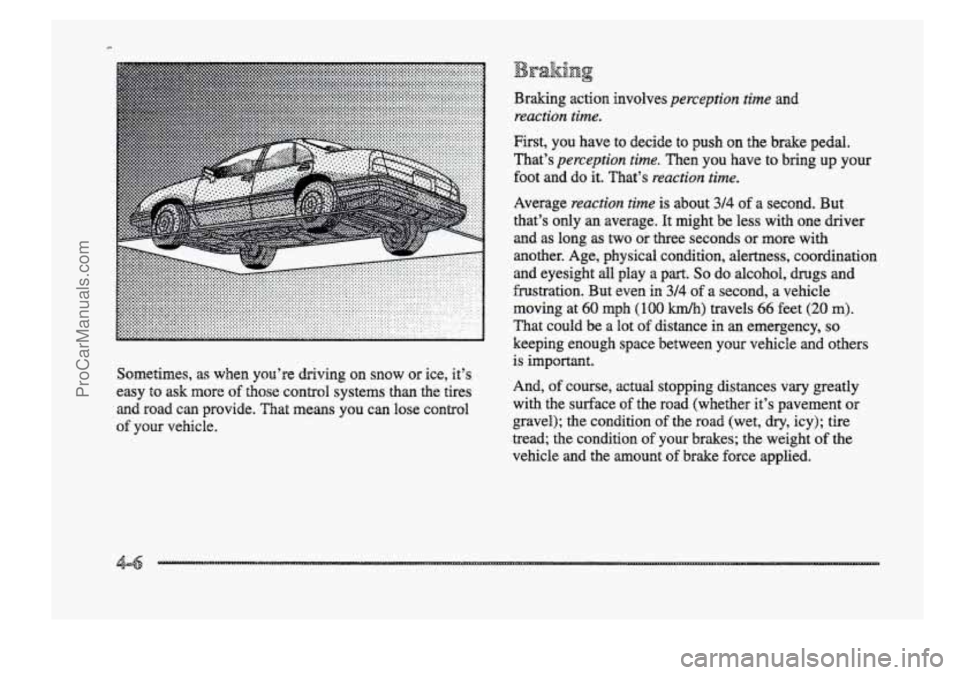Page 97 of 426

k;zgaA 'T:..:&pa: & LnP :V3;.,,t (.$ dL Bb* pFq- {p :.A AA &L \'& J
Your vehicle has a brake-transaxle shift interlock. You
have to fully apply your regular brake before you can
shift
from PARK (P) when the ignition is in RUN. See
"Automatic Transaxle" in the Index.
If you cannot shift out of PARK (PI, ease pressure on
the shift lever -- push the shift 'lever all the way into
PARK (PI as you maintain brake application. Then
move the shift lever into the gear
YOU want.
If you ever hold the brake pedal down but still can't
shift out of PARK (P), try this:
1.
2.
3.
4.
5.
Turn the key to OW. Open and close the driver's
door to turn
off the retained accessory power feature.
Apply
and hold the brake until the end of Step 4.
Shift to NEUTRAL (N).
Start the vehicle and then shift to the drive gear
you want.
Have the vehicle fixed as soon as you can. CAUTION:
Things that can burn could touch hot exhaust
parts under your vehicle and ignite. Don't park
over papers, leaves,
dry grass or other things that
can burn.
.. . .. 3 32 drn-2
ProCarManuals.com
Page 99 of 426
I& can be dangerous to get ut of your vehicle if
the shift lever is not fully in PARK (PI with the
parking brake firmly set. Your vehicle can roll.
Don’t leave your vehicle when the engine is
running unless you have to. If you’ve left the
engine mnnhg, the vehicle can BP~QV~ suddenly.
You or others could be injured. To be sure YOW
vehicle won’t move, even when you’re OEI fairly
level ground, always set your parking brake and
move the shift lever to PARK (PI.
H701Iow the proper steps to be sure your vehicle won’t
move. See “Shifting Into PARK (P)” in the Index.
If YOU are parking on a hill and if you’re pulling a
trailer, also see “Towing a Trailer” in the Index. Switches
on the driver’s
mest conltrol.each of the
windows while the
ignition is on or retained accessory
power
is active. In addition, each passenger door has a
switch for its own window.
2-33
ProCarManuals.com
Page 144 of 426

With the anti-lock brake
system, the
Iight(s) will
come on when you start
your engine and may stay
on for several seconds.
1 That’s BzorfnaI.
The anti-lock brake system warning light should come
on briefly when YOU turn the ignition key to RUN. If the
light doesn’t come on then, have it fixed SO it will be
ready
to wm you if there is a problem.
OFF
This warnirag light should
come on briefly 2s you start
the engine. If the warning
iight doesn’t corne on then,
have it fixed so it will be
ready
to warn you if there’s
a problem.
If it stays on, or comes on when you’re driving, there
may be a problem with your traction control system and
your vehicle may need service. When this warning light
is on, the system will not limit wheel spin. Adjust your
The traction control system wming light may come on
for the foIlowing reasons:
dr;ivi3g accordingly.
If yos turn the system off by pressing the button
located on the end of the shift lever, the warning
light will come on and stay on. To turn the system
back on, press the button again. The warning light
should go off. (See “Traction Control System” in the
Index
for more kf~m;ation.)
ProCarManuals.com
Page 204 of 426

The best advice anyone can give about driving is:
Drive defensively.
Please
start with a very important safety device in your
Buick: Buckle up. (See “’Safety Belts” in the Index.) Defensive driving
redly means “be ready
for mything.”
On city streets, rural roads or freeways, it means
“always expect
the unexpected.”’
Assume that pedestrians or other drivers are going
to be
careless and make mistakes. Anticipate what they might
do. Be ready for their mistakes.
Rear-end collisions
are about the most preventable of
accidents.
Yet they are common. Allow enough
following distance. It’s the best defensive driving
maneuver, in
both city and wd driving. You never
know when
the vehicle in front of you is going to brake
or suddenly.
Defensive driving requires that a driver concentrate
on the driving task. Anything that distracts from the
driving task
-- such as concentrating on a cellular
telephone call, reading, or reaching for something
on
the floor -- makes proper defensive driving more
difficult and can even cause a collision, with resulting
injury.
Ask a passenger to help do things like this, or
pull
off the road in a safe place to do them yourself.
These simple defensive driving techniques coukl save
your Me.
4-2
ProCarManuals.com
Page 207 of 426
YO:; have three systems that make YQLX vehick go wircre
you want it to go. They are the brakes, the steering anti
the accelerator. AH three systems have to do their work
at the places where the tires meet the road.
ProCarManuals.com
Page 208 of 426

Sometimes, as when you’re driving on snow or ice, it’s
easy
to ask more of hose control systems than the tires
and road can provide.
That means you can lose control
of your vehicle. Braking
action involves perreption
time and
reaction time.
First, you have to decide to push on the brake pedal.
That’s
perception time. Then you have to bring up your
foot and do it. That’s reaction time.
Average reaction time is about 314 of a second. But
that’s
only an average. It might be less with one driver
and as long
as two OS three seconds or more with
another. Age, physical condition, alertness, coordination
and eyesight
dl play a part. So do alcohol, drugs and
frustration. But even
in 3/4 of a second, a vehicle
moving at
60 mpph (100 km/h) travels 66 feet (20 m).
That could be a lot of distance in an emergency, so
keeping enough space between your vehicle and others
is important.
And,
of course, actual stopping distances vary greatly
with the surface
of the road (whether it’s pavement or
gravel); the condition
of the road (wet, dry, icy); tire
tread; the condition
of your brakes; the weight of the
vehicle and the
amount of brake force applied.
ProCarManuals.com
Page 209 of 426
Avoid Reedless heavy braking. Some people drive in
spurts -- heavy acceleration followed by heavy
braking -- rather than keeping pace with traffic. This is a
mistake. Your brakes may not have time to COO^ between
hard stops. Your brakes will wear out much Easter if you
dc a lot of heavy braking. If YOU keep pace with the
traffic ‘ad allow realistic follewing distances, you will
eliminate a lot of unnecessary braking. That means
better
braking and longer brake life.
If your engine ever steps while you’re driving, brake
nomctHBy but don’t pump your brakes. HE you do, the
pedal may get harder to push down. If your engine
stops, you will still have some power brake assist. But
you will use it when you brake. Once the power assist is
used
up, it may take longer to stop and the brake pedal
will be hxder to push.
ProCarManuals.com
Page 210 of 426
..... ... ..,. . ....... .... .... ......
You can steer around the obstacle while braking hard.
As you brake, your CQIII~U~~I- keeps receiving updates on
wheel speed and c~ntgols braking pressure accordingly.
ProCarManuals.com